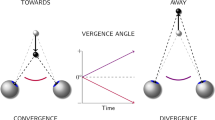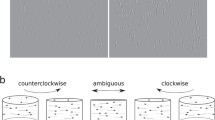Summary
The ability of human beings to shift their vergence between multiple disparity stimuli was investigated. The stimulus was a stereogram consisting of a single bar (1× 0.3°) projected in the center of a larger circular pattern (28° dia) of dots (0.3° dia). In the initial condition, the subjects perceived a single bar in the center of a cluster of dots, all lying in a single depth plane. The subjects were instructed to fixate either the bar or one of the dots close to the bar. Stepwise changes of target-vergence of either the bar, or of all dots, or of both configurations in opposite directions, were imposed in a random sequence. Under these conditions, ocular vergence was controlled by the target-vergence of the selected target at all times, even if this implied a loss of binocular fusion for the non-selected target. The effect of target selection per se, without concomitant changes in retinal position of the selected target, was studied in two experienced subjects with stabilized image techniques. The subjects viewed a configuration containing short vertical bars placed at either side of a long vertical bar. The short bars on different sides of the long bar had opposite (crossed or uncrossed) disparities. After stabilization of the configuration while the subject fixated the long bar, subjects attempted to fixate the short bars alternatingly. Due to the stabilization the ensuing eye movements did not affect the retinal positions, and thus the disparity, of the bars. Attempted fixation of a para-foveally viewed, short bar induced vergence responses in the appropriate direction. These vergence responses would have reduced disparity of the selected target if this had not been stabilized, at the expense of increasing disparity of non-selected targets. From this result we conclude that, by the mechanism of target selection, disparity information of the selected target is gated to a subsystem processing disparity which controls vergence.
Similar content being viewed by others
References
Alpern M, Ellen P (1956) A quantitative analysis of the horizontal movements of the eyes in the experiments of Johannes Müller. II. Effect of variation in target separation. Am J Ophthalmol 42: 296–303
Becker W, Fuchs AF (1969) Further properties of the human saccadic system: eye movements and correction saccades with and without fixation points. Vision Res 9: 1247–1258
Burian HM (1939) Fusional movements: the role of peripheral retinal stimuli. Arch Ophthalmol 21: 486–491
Collewijn H, Van der Mark F, Jansen TC (1975) Precise recording of human eye movements. Vision Res 15: 447–450
Erkelens CJ (1987) Adaptation of ocular vergence to stimulation with large disparities. Exp Brain Res 66: 507–516
Erkelens CJ (1988) Ocular vergence induced by changes in spatially selective visual attention. Perception 17: A8
Erkelens CJ, Regan D (1986) Human ocular vergence movements induced by changing size and disparity. J Physiol 379: 145–169
Erkelens CJ, Van der Steen J, Steinman RM, Collewijn H (1989a) Ocular vergence under natural conditions. I. Continuous changes of target distance along the median plane. Proc R Soc Lond B 236: 417–440
Erkelens CJ, Steinman RM, Collewijn H (1989b) Ocular vergence under natural conditions. II. Gaze shifts between real targets differing in distance and direction. Proc R Soc Lond B 236: 441–465
Grüsser OJ (1986). The effect of gaze motor signals and spatially directed attention on eye movements and visual perception. In: Freund HJ, Büttner U, Cohen B, Noth J (eds) Progress in brain research, Vol 64. Elsevier North Holland, Amsterdam, pp 391–404
Hampton DR, Kertesz AE (1983) Fusional vergence response to local peripheral stimulation. J Opt Soc Am 73: 7–10
Kertesz AE (1981) Effect of stimulus size on fusion and vergence. J Opt Soc Am 71: 289–293
Kommerell G, Täumer R (1972) Investigation of the eye tracking system through stabilized retinal images. Bibl Ophthalmol 82: 288–297
Rashbass C (1981) Reflexions on the control of vergence. In: Zuber BL (ed) Models of oculomotor behavior and control. CRC Press, Boca Raton, pp 139–148
Rashbass C, Westheimer G (1961) Disjunctive eye movements. J Physiol 159: 339–360
Regan D, Erkelens CJ, Collewijn H (1986) Visual field defects for vergence eye movements and for stereomotion perception. Invest Ophthalmol Vis Sci 27: 806–819
Robinson DA (1963) A method of measuring eye movements using a scierai search coil in a magnetic field. IEEE Trans Biomed Electron 10: 137–145
Steinbach MJ, Held R (1968) Eye tracking of observer-generated target movement. Science 161: 187–188
Westheimer G, Mitchell G (1956) Eye movement responses to convergent stimuli. Am Arch Ophthalmol 55: 848–856
Author information
Authors and Affiliations
Rights and permissions
About this article
Cite this article
Erkelens, C.J., Collewijn, H. Control of vergence: Gating among disparity inputs by voluntary target selection. Exp Brain Res 87, 671–678 (1991). https://doi.org/10.1007/BF00227093
Received:
Accepted:
Issue Date:
DOI: https://doi.org/10.1007/BF00227093




